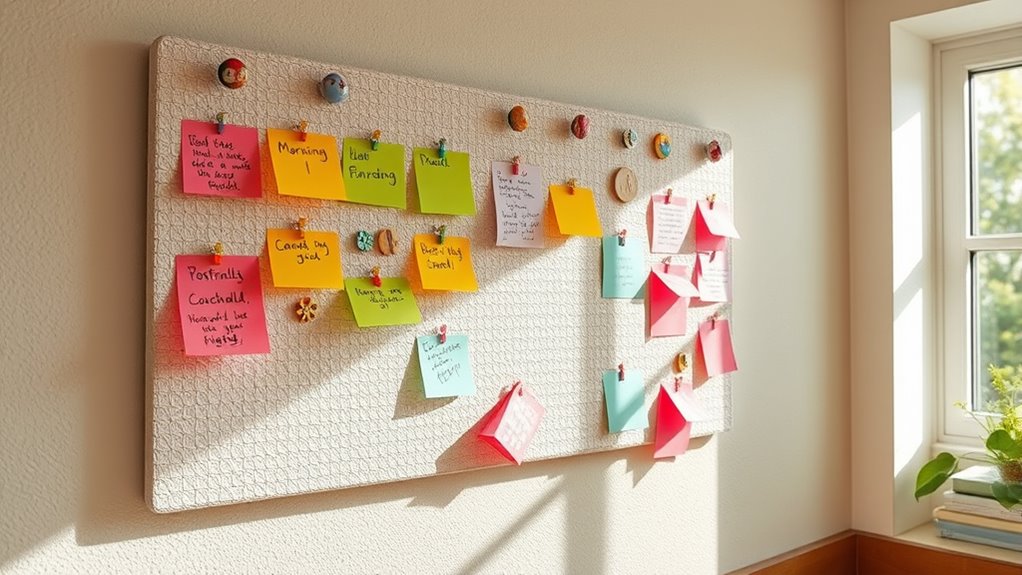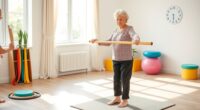To make a routine board that actually gets used, choose a simple, visually appealing format like a whiteboard or digital app with clear headings and color coding. Keep it flexible to allow spontaneous updates, and establish a consistent daily check-in time. Personalize it with inspiring images or quotes to boost motivation. When designed thoughtfully, your routine board becomes a dependable tool for maintaining your memory and mood—keep exploring for practical tips to optimize its use.
Key Takeaways
- Keep the routine board simple, visually engaging, and customizable to encourage regular use and adherence.
- Use consistent times and anchor points to establish habits and reduce mental clutter.
- Incorporate colors, icons, or quotes to personalize and motivate ongoing engagement.
- Regularly review and adjust tasks to ensure they remain realistic and relevant.
- Make the routine board a daily ritual to promote stability, memory support, and emotional well-being.

Routine boards are often overlooked or neglected, but when designed and implemented effectively, they become powerful tools that get used daily. You might think a simple chart or schedule isn’t worth the effort, but a well-crafted routine board can transform your day-to-day life. It helps you stay organized, reduces anxiety, and keeps your memory and mood steady. The key is making it user-friendly and engaging enough that you look forward to consulting it every day.
Start by choosing a format that suits your space and preferences. Whether you prefer a physical whiteboard, a corkboard with sticky notes, or a digital app, the goal is to create something visible and accessible. Keep it simple—use clear headings, color coding, and icons to categorize tasks and activities. When you make your routine visually appealing, you’re more likely to notice and follow through with it. The design should also be flexible; life is unpredictable, so your routine board needs to adapt easily to changes. Leave space for spontaneous additions or adjustments, so it remains relevant and not just a rigid schedule that causes frustration.
Next, break your day into manageable segments—morning, afternoon, and evening—and assign specific tasks or goals to each. Be realistic about what you can accomplish, and avoid overloading your schedule. When your routine feels achievable, your mood stays steady because you’re not overwhelmed. Incorporate essential activities like medication times, meals, exercise, and relaxation. These anchor points give your day structure and help your brain remember what’s next, reducing mental clutter and forgetfulness. Additionally, understanding the importance of contrast ratio can help you better optimize your environment for visual clarity and comfort.
Consistency is crucial. Use your routine board as a daily reference and make it a habit to check it at the same times each day. Doing so reinforces your memory and creates a sense of stability. If you notice certain activities are consistently left undone, reevaluate and adjust your schedule. A routine board should serve as a helpful guide, not a source of stress. Celebrate small wins—checking off completed tasks boosts your mood and encourages continued use. Over time, the routine becomes second nature, and your mental clarity improves because you’re less likely to forget important tasks or feel anxious about what comes next.
Lastly, personalize your routine board to reflect what motivates you. Use favorite colors, quotes, or images that inspire positivity. When it feels meaningful and tailored to your needs, you’ll naturally want to engage with it daily. Remember, the purpose of a routine board isn’t just to organize tasks but to support your emotional well-being by creating predictability and control. When designed thoughtfully, your routine board becomes an essential part of your daily rhythm—something you rely on to keep your memory sharp and your mood balanced.
Frequently Asked Questions
How Can I Make Routine Boards More Engaging for Children?
You can make routine boards more engaging for children by using colorful visuals, stickers, and fun icons to represent daily tasks. Involve them in creating the board, letting them choose images or themes they like. Keep updates simple and positive, praising their efforts. Incorporate interactive elements like movable pieces or checklists, making routines feel like a game. This approach encourages participation and helps children stay motivated to follow their schedules.
What Materials Are Best for Durable, Long-Lasting Routine Boards?
Think of your routine board as a sturdy ship that needs durable materials. Use laminated paper or waterproof vinyl for images and labels—these resist wear and tear. For frames, opt for aluminum or plastic, which withstand daily handling. I once made a board with laminated visuals that lasted years without damage. These materials guarantee your board stays intact, engaging, and reliable, even with frequent use.
How Do I Customize Routine Boards for Different Age Groups?
To customize routine boards for different age groups, you should tailor visuals and language accordingly. For young children, use bright colors, simple pictures, and clear symbols to convey tasks. For teens, opt for more sophisticated designs, minimal text, and digital options if preferred. For older adults, incorporate larger fonts, high contrast, and easy-to-read icons. Adjust content to match their daily routines, interests, and cognitive abilities to guarantee engagement and usability.
What Are Common Challenges in Maintaining Routine Boards?
You’ll find that maintaining routine boards feels like trying to tame a wild tornado—things get lost, forgotten, or ignored! Distractions, lack of motivation, and changing needs make it tough to stick with them. Plus, if they’re not personalized or engaging, they become as exciting as watching paint dry. But with patience, regular updates, and making it fun, you can turn your routine board into a powerhouse of consistency and calm!
How Can I Involve Family Members in Using the Routine Boards?
You can involve family members by making the routine boards a shared activity. Encourage everyone to add their tasks, notes, or positive affirmations, turning it into a collaborative project. Regularly review the board together, celebrating successes and adjusting tasks as needed. When family members see the board as a team effort, they’re more likely to stay engaged and use it consistently, helping keep memory and mood steady.
Conclusion
By incorporating a routine board into your daily life, you create a visual anchor that keeps your memory sharp and your mood steady. For example, imagine tracking your goals and accomplishments — it not only boosts motivation but also reduces stress. When you consistently use your board, it becomes a reliable tool to stay organized and focused, turning a simple habit into a powerful strategy for maintaining mental clarity and emotional balance every day.









